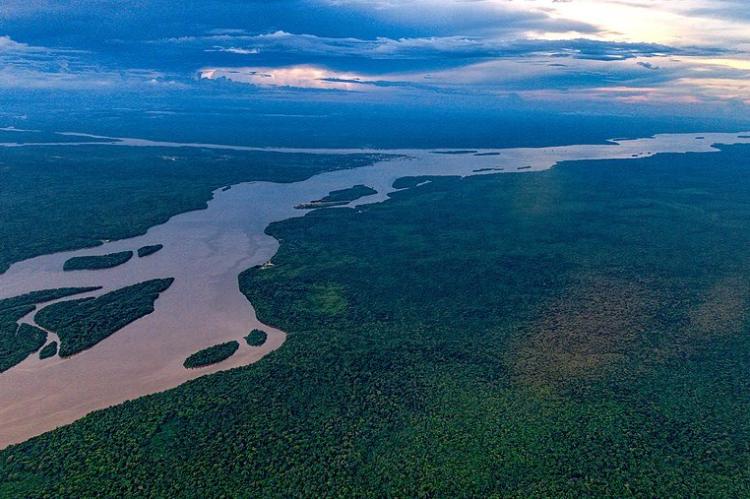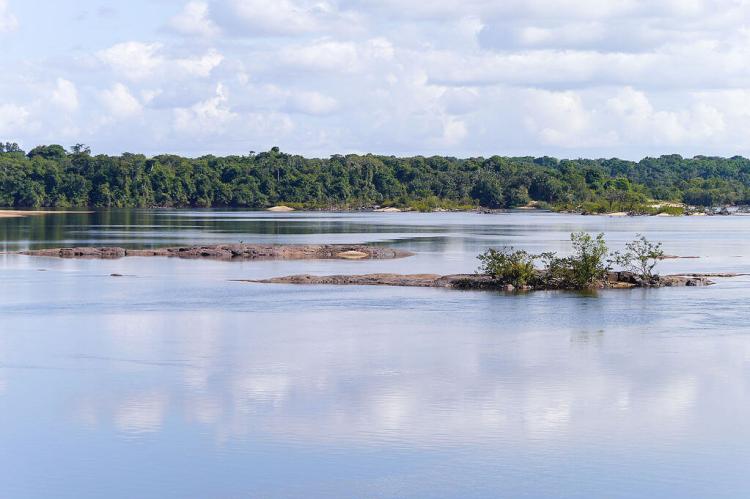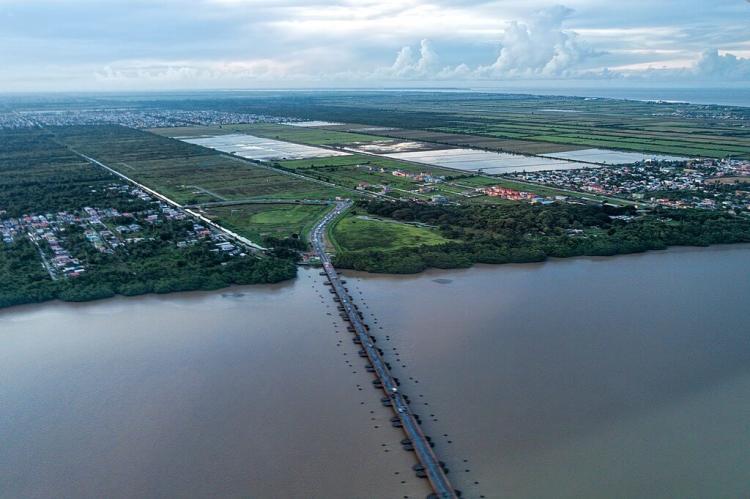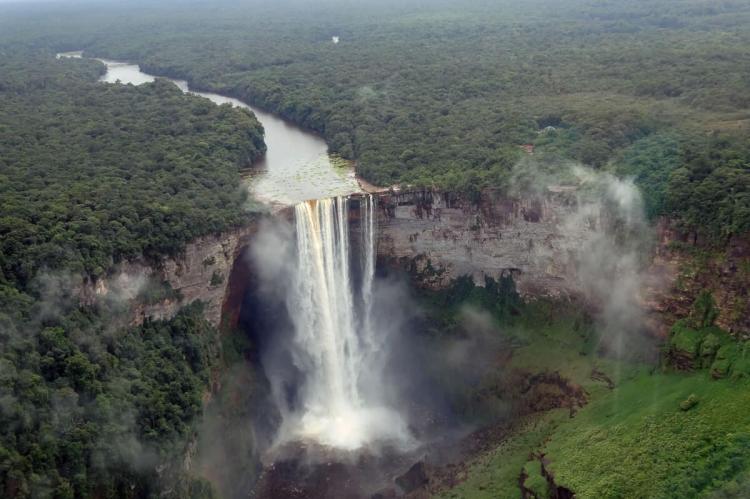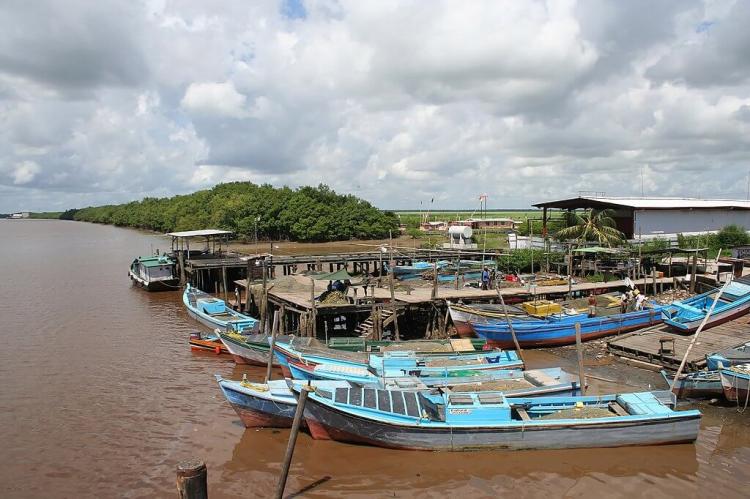Water Bodies of Guyana
From large rivers and extensive estuaries to coastal lagoons and offshore zones, Guyana's bodies of water provide a wealth of natural resources, support a wide array of wildlife, and offer numerous opportunities for recreation and livelihoods.
Water Bodies of Guyana
Guyana, located on the northern coast of South America, is home to a diverse range of bodies of water that play a crucial role in shaping its landscape, ecosystems, and economy.
From large rivers and extensive estuaries to coastal lagoons and offshore zones, Guyana's bodies of water provide a wealth of natural resources, support a wide array of wildlife, and offer numerous opportunities for recreation and livelihoods.
Notable Lakes and Lagoons
Lake Awala: Lake Awala is a crater lake in the Rupununi savannas. The lake is surrounded by lush vegetation and is home to various wildlife, including caimans, turtles, and birds.
Lake Mainstay: Lake Mainstay is one of the most well-known lakes in Guyana. It is an artificial lake created by the Mainstay Dam, constructed to supply water to rice fields in the region. The lake is in the Pomeroon-Supenaam Region, providing a vital water source for agricultural activities.
Lake Capoey: Lake Capoey is an artificial lake in Guyana in the Pomeroon-Supenaam Region. It was created by damming the Capoey River and serves as a reservoir for irrigation and water supply for the surrounding communities.
Lake Amuku: Lake Amuku is located in the Cuyuni-Mazaruni Region in western Guyana. It is a natural lake formed in the Rupununi savannah region and is surrounded by pristine wetlands, providing a habitat for various bird species and other wildlife.
Mabuiacuma Lagoon: Mabuiacuma Lagoon is a large lagoon in the Rupununi savannas. The lagoon is home to various wildlife, including caimans, turtles, and birds. It is also a popular destination for fishing and birdwatching.
Barima-Waini Lagoon: Barima-Waini Lagoon is the largest lagoon in Guyana. The lagoon is located in the country's northwestern part and is home to various wildlife, including caimans, turtles, and birds. It is also a popular destination for fishing and boat tours.
Cana Island Lagoon: Cana Island Lagoon is a small lagoon in the Essequibo River. The lagoon is surrounded by lush vegetation and is home to various wildlife, including caimans, turtles, and birds. It is also a popular destination for swimming and fishing.
Notable Dams and Reservoirs
Tapakuma Irrigation Dam and Reservoir: The Tapakuma Irrigation Dam is located in the Pomeroon-Supenaam Region of Guyana. It was built to create the Tapakuma Reservoir, which is primarily used for irrigation, providing water to nearby rice fields, and supporting agricultural activities in the region.
Abary Irrigation Dam and Reservoir: The Abary Irrigation Dam in the East Berbice-Corentyne Region creates the Abary Reservoir. This reservoir is essential for supporting agricultural activities, particularly rice cultivation, in the surrounding areas.
Mahaicony Abary Agricultural Development Authority (MAADA) Dam: The MAADA Dam is another vital irrigation structure in Guyana. It serves the Mahaicony-Abary agricultural region, providing water for irrigation and supporting rice production and other farming activities.
Kingelly Irrigation Dam and Reservoir: The Kingelly Irrigation Dam is located in the East Berbice-Corentyne Region and creates the Kingelly Reservoir. This reservoir is an integral part of the country's agricultural infrastructure, contributing to irrigation in the region.
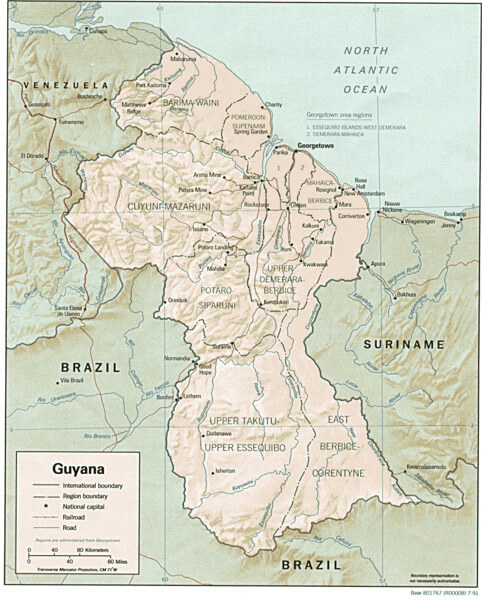
Guyana shaded relief map.
Notable Rivers and Waterfalls
Essequibo River: The Essequibo River is the largest and longest river in Guyana, spanning approximately 1,010 km (630 mi). It originates in the Acarai Mountains in southern Guyana and flows northward through the central part of the country before emptying into the Atlantic Ocean. The Essequibo River is of great historical and cultural significance, having served as a major waterway for early European explorers and the region's indigenous peoples.
Potaro River: The Potaro River originates in the highlands of the Kaieteur Plateau in central Guyana. It flows in a northerly direction through dense rainforests, eventually joining the Essequibo River, one of the largest rivers in Guyana. The Potaro River's headwaters are fed by numerous smaller streams and creeks flowing from the surrounding rainforest-covered mountains.
Kaieteur Falls: The Potaro River is renowned for being the waterway over which the majestic Kaieteur Falls plunges. The falls are approximately 251 meters (822 feet) tall, making them one of the tallest single-drop waterfalls in the world. The Potaro River's flow over the sandstone cliffs creates this breathtaking natural wonder, attracting tourists and nature enthusiasts from around the globe.
Demerara River: The Demerara River is another significant river in Guyana, approximately 346 km (215 mi) long. It originates in the central part of the country and flows southward, passing through the capital city, Georgetown, before reaching the Atlantic Ocean. The Demerara River is vital in transporting goods and people, serving as a critical waterway for commerce and trade.
Berbice River: The Berbice River is located in the eastern part of Guyana and stretches about 595 km (370 mi). It originates in the highlands of the Rupununi Savannahs and flows northward, eventually reaching the Atlantic Ocean. The Berbice River has historically been important for transportation and trade, with its estuary forming a significant port for shipping and commerce.
Corentyne River: The Corentyne River forms part of the border between Guyana and Suriname. It flows along Guyana's eastern boundary and stretches approximately 724 km (450 mi). The river is significant for cross-border trade and transportation between the two countries.
Pomeroon River: The Pomeroon River is about 104 km (65 mi) long and is located in the western part of Guyana. It flows through the Pomeroon-Supenaam Region and empties into the Atlantic Ocean. The Pomeroon River is known for its lush mangrove forests and traditional agriculture, including rice and coconut cultivation.
Mazaruni River: The Mazaruni River is approximately 346 km (215 mi) long and is located in the western part of Guyana. It originates in the Pakaraima Mountains and flows northward, eventually joining the Essequibo River. The Mazaruni River is known for its scenic beauty and is essential for the country's gold mining industry.
Cuyuni River: The Cuyuni River is another significant river in western Guyana, flowing approximately 462 km (287 mi) in length. It also originates in the Pakaraima Mountains and joins the Mazaruni River before reaching the Essequibo River. The Cuyuni River is known for its gold deposits and supports mining activities in the region.
Rupununi River: The Rupununi River is a significant waterway in the Kanuku Mountains, located in the southern part of Guyana, near the Brazilian border. It flows generally northwardly, passing through the picturesque Rupununi savannah.
Burro-Burro River: The Burro-Burro River flows directly through the Iwokrama Rainforest in Guyana. The river runs through the forest's center, and most of its watershed is within it. The Burro-Burro River is an important water source for the Macushi and is also used for ecotourism.
Notable Canals
East Demerara Water Conservancy (EDWC) Canals: The East Demerara Water Conservancy is a large reservoir and canal system located on the east side of Guyana's capital, Georgetown. The canals in this system regulate water levels in the conservancy and drain excess water during heavy rainfall, preventing flooding in low-lying coastal areas.
Mahaica-Mahaicony-Abary (MMA) Drainage and Irrigation Canals: The MMA region in Guyana, located on the east coast, is characterized by a drainage and irrigation canal network. These canals are essential for managing water levels in the agricultural fields, allowing for rice cultivation and other crops. They also help control flooding during the rainy season.
Berbice River Canals: The Berbice River, one of Guyana's major rivers, has a canal network that facilitates transportation and irrigation in the surrounding areas. These canals support rice and sugar cane cultivation and provide water access to villages and communities along the riverbanks.
Pomeroon River Canals: The Pomeroon River, located in the Pomeroon-Supenaam Region, has a network of canals used for drainage and irrigation in the region's agricultural lands. The canals contribute to cultivating rice, coconuts, and other crops.
Demerara River Canals: The Demerara River, which flows along the coast and through Georgetown, has canals that serve various purposes, including drainage and transportation. Some of these canals facilitate access to riverfront communities and contribute to the region's agricultural activities.
Essequibo River Canals: The Essequibo River, one of the longest rivers in Guyana, also has a network of canals in its estuary area. These canals help manage water and provide access to fishing grounds and river communities.
